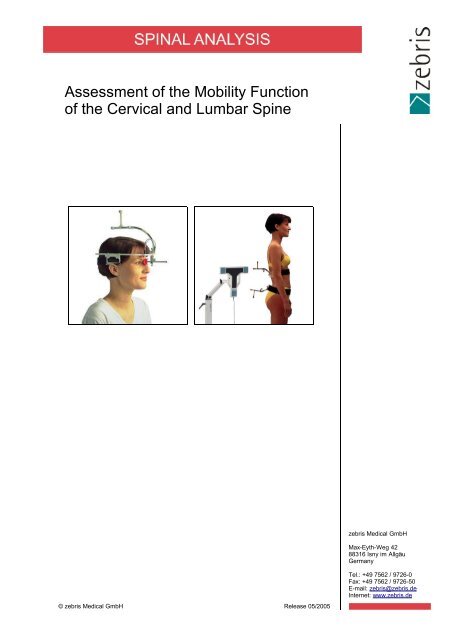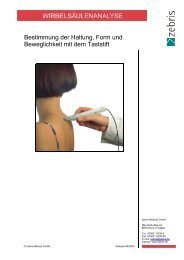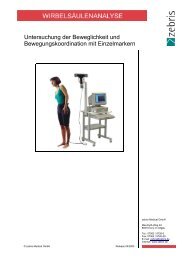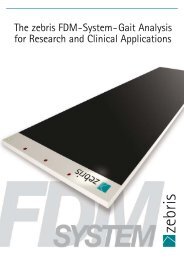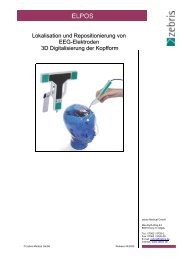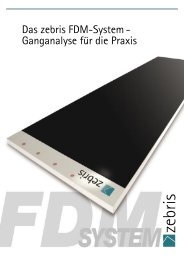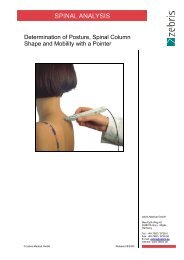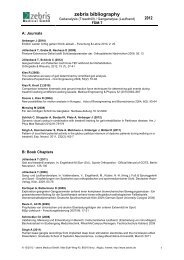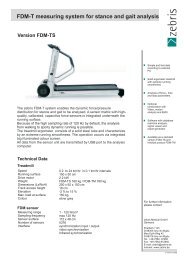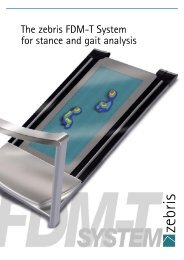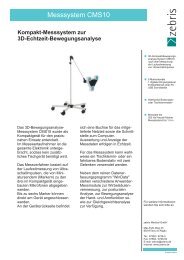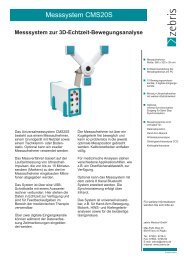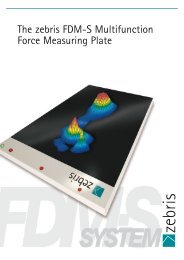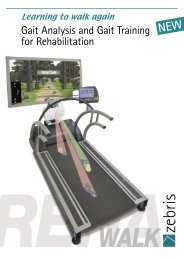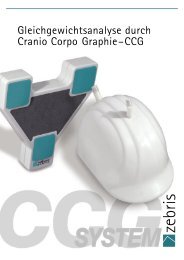Assessment of the Mobility Function of the Cervical and Lumbar Spine
Assessment of the Mobility Function of the Cervical and Lumbar Spine
Assessment of the Mobility Function of the Cervical and Lumbar Spine
You also want an ePaper? Increase the reach of your titles
YUMPU automatically turns print PDFs into web optimized ePapers that Google loves.
<strong>Assessment</strong> <strong>of</strong> <strong>the</strong> <strong>Mobility</strong> <strong>Function</strong><br />
<strong>of</strong> <strong>the</strong> <strong>Cervical</strong> <strong>and</strong> <strong>Lumbar</strong> <strong>Spine</strong><br />
© zebris Medical GmbH Release 05/2005<br />
zebris Medical GmbH<br />
Max-Eyth-Weg 42<br />
88316 Isny im Allgäu<br />
Germany<br />
Tel.: +49 7562 / 9726-0<br />
Fax: +49 7562 / 9726-50<br />
E-mail: zebris@zebris.de<br />
Internet: www.zebris.de
Features<br />
• All measurement data can be observed<br />
directly on <strong>the</strong> monitor in realtime.<br />
• Comparison <strong>of</strong> several measurements<br />
through multiple display.<br />
• Printout via color printer at low operating<br />
costs.<br />
• The measured data can be exportet to<br />
ASCII data files <strong>and</strong> fur<strong>the</strong>r processed.<br />
• Form for entry <strong>of</strong> patient data, findings,<br />
etc.<br />
• Easy menu-driven operation.<br />
• Automatic display <strong>of</strong> st<strong>and</strong>ard <strong>and</strong> limit<br />
values.<br />
• Program operates under Windows 98,<br />
2000 <strong>and</strong> XP.<br />
Introduction<br />
The examination <strong>of</strong> <strong>the</strong> head movement<br />
has become routine during <strong>the</strong> clinical<br />
examination <strong>of</strong> patients with problems in <strong>the</strong><br />
area <strong>of</strong> <strong>the</strong> cervical spine.<br />
In addition to checking <strong>the</strong> course <strong>of</strong> treatment,<br />
when carrying out reviews in practice,<br />
for example after traffic accidents or to<br />
assess <strong>the</strong> ability to work, an objective,<br />
precise <strong>and</strong> reproducible deter-mination <strong>of</strong><br />
<strong>the</strong> cervical <strong>and</strong> lumbar spine function is<br />
required.<br />
The measuring systems, toge<strong>the</strong>r with <strong>the</strong><br />
special application aids, permits <strong>the</strong> precise<br />
<strong>and</strong> fast determination <strong>of</strong> mobility <strong>and</strong><br />
coordinated movements <strong>of</strong> all degrees <strong>of</strong><br />
freedom <strong>of</strong> spinal column sections.<br />
The movement can be carried out both in<br />
an active as well as in a passive manner.<br />
Measuring principle<br />
The position <strong>of</strong> three ultrasound transmitters<br />
on a measuring <strong>and</strong> reference<br />
mount is continuously determined by<br />
means <strong>of</strong> <strong>the</strong> process for measuring <strong>the</strong><br />
transmission time <strong>of</strong> <strong>the</strong> sound pulses.<br />
From this, all <strong>the</strong> angular <strong>and</strong> translation<br />
movements can be computed.<br />
Apart from <strong>the</strong> extent <strong>of</strong> movement, in<br />
particular deviating movements <strong>and</strong> <strong>the</strong><br />
quality <strong>of</strong> movement can be precisely<br />
determined.<br />
Win<strong>Spine</strong> Triple © zebris Medical GmbH
The Win<strong>Spine</strong> s<strong>of</strong>tware<br />
The "Win<strong>Spine</strong>" s<strong>of</strong>tware for spine analysis<br />
can run under up to date Windows<br />
operating systems.<br />
The Win<strong>Spine</strong> database system has three<br />
levels for organising <strong>the</strong> measured data:<br />
The highest level is <strong>the</strong> project level. Here<br />
you can memorise various projects, patient<br />
groups or program users.<br />
In <strong>the</strong> next level, <strong>the</strong> patient names are<br />
input. In <strong>the</strong> final level, <strong>the</strong> measured data<br />
files are listed.<br />
The program contains a st<strong>and</strong>ard data-base<br />
with which <strong>the</strong> bar charts in <strong>the</strong> report can<br />
be superimposed with age <strong>and</strong> gender<br />
specific st<strong>and</strong>ard data.<br />
In <strong>the</strong> screen page for preparing <strong>the</strong><br />
measurement, different types <strong>of</strong><br />
examinations can be selected.<br />
In addition, adjustments are made here to<br />
<strong>the</strong> measuring system, such as <strong>the</strong> angle <strong>of</strong><br />
inclination <strong>of</strong> <strong>the</strong> measuring sensor, <strong>the</strong><br />
measuring rate, <strong>the</strong> distance or <strong>the</strong> scaling<br />
<strong>of</strong> <strong>the</strong> measuring curves during <strong>the</strong> real<br />
time measurement. These settings are<br />
memorised for every measuring arrangement.<br />
For measuring <strong>the</strong> cervical or lumbar spine<br />
function <strong>the</strong> "Triple <strong>Cervical</strong>" or "Triple<br />
<strong>Lumbar</strong>" examination must be set.<br />
© zebris Medical GmbH Win<strong>Spine</strong> Triple
Preparation <strong>of</strong> <strong>the</strong> patient<br />
The cervical spine is examined with <strong>the</strong><br />
Triple <strong>Cervical</strong> marker set.<br />
To examine <strong>the</strong> cervical spine, a special<br />
head mount is used with integrated triple<br />
markers.<br />
This permits a quick <strong>and</strong> reproducible<br />
fastening on <strong>the</strong> head. In addition, a triple<br />
reference marker is required for fastening<br />
on <strong>the</strong> shoulder.<br />
Examination <strong>of</strong> <strong>the</strong> lumbar spine with <strong>the</strong><br />
Triple <strong>Lumbar</strong> marker set.<br />
The triple reference markers are placed on<br />
<strong>the</strong> sacrum <strong>and</strong> are fastened to <strong>the</strong> body<br />
with <strong>the</strong> elastic Velcro strip. The marker<br />
mount points downwards.<br />
The triple measuring marker is placed in<br />
way <strong>of</strong> <strong>the</strong> lower thoracic spine <strong>and</strong> is also<br />
fixed in place with a Velcro strip.<br />
By means <strong>of</strong> <strong>the</strong> special mounts, an<br />
optimum transmission <strong>of</strong> <strong>the</strong> ultrasound<br />
pulses to <strong>the</strong> measuring sensor is ensured<br />
during all movements.<br />
Win<strong>Spine</strong> Triple © zebris Medical GmbH
Carrying out <strong>the</strong> measurement<br />
Examination <strong>of</strong> <strong>the</strong> cervical spine:<br />
A calibration in <strong>the</strong> neutral position is<br />
initially carried out.<br />
The patient <strong>the</strong>n makes head movements<br />
up to <strong>the</strong> maximum forward <strong>and</strong> backward<br />
inclination.<br />
As far as possible, <strong>the</strong> movements are<br />
carried out uniformly <strong>and</strong> repeatedly.<br />
The next measurement consists <strong>of</strong> <strong>the</strong> axial<br />
rotation <strong>of</strong> <strong>the</strong> head.<br />
In a fur<strong>the</strong>r procedure, sideways movements<br />
are carried out.<br />
Selecting <strong>the</strong> time sections in <strong>the</strong> "Signal Viewer"<br />
Upon completion <strong>of</strong> <strong>the</strong> measurement, by<br />
setting <strong>the</strong> markings interactively, <strong>the</strong><br />
time sections for analysis in <strong>the</strong> report are<br />
selected. The report is <strong>the</strong>n produced<br />
automatically.<br />
Upon completion <strong>of</strong> this measurement, <strong>the</strong><br />
rotational movements in maximum forward<br />
<strong>and</strong> backward inclination <strong>of</strong> <strong>the</strong> head are<br />
carried out.<br />
The examination <strong>of</strong> <strong>the</strong> lumbar spine is<br />
carried out in <strong>the</strong> same manner as <strong>the</strong><br />
cervical spine.<br />
However, in this cases, only <strong>the</strong> movements<br />
for forward <strong>and</strong> backward inclination,<br />
rotation <strong>and</strong> sideways movement are<br />
examined.<br />
In <strong>the</strong> signal viewer, individual curves can<br />
also be enlarged <strong>and</strong> superimposed or<br />
individual measured data can be obtained.<br />
Data export<br />
The measured data can be exported <strong>and</strong><br />
fur<strong>the</strong>r processed as ASCII data files.<br />
© zebris Medical GmbH Win<strong>Spine</strong> Triple
<strong>Cervical</strong> <strong>Spine</strong> Report<br />
In <strong>the</strong> report, <strong>the</strong> measured values <strong>of</strong> <strong>the</strong><br />
maximum motional extent are shown toge<strong>the</strong>r<br />
with st<strong>and</strong>ard ranges as bar charts.<br />
The measured values are calculated from<br />
<strong>the</strong> maximum or mean values <strong>of</strong> <strong>the</strong> curve<br />
sections chosen in <strong>the</strong> signal viewer. The<br />
changeable st<strong>and</strong>ard ranges are marked as<br />
light colour sections <strong>and</strong> are memorised in<br />
a database in an age <strong>and</strong> gender dependent<br />
manner.<br />
The display <strong>of</strong> <strong>the</strong> mobility on its own<br />
cannot provide adequate information on <strong>the</strong><br />
mobility pattern.<br />
For example, an apparently adequate<br />
mobility can be achieved through erasive<br />
movements. In addition, <strong>the</strong> observation <strong>of</strong><br />
<strong>the</strong> actual motion sequence provides<br />
valuable information for evaluating <strong>the</strong><br />
function.<br />
To display <strong>the</strong> movement curve <strong>and</strong> alternative,<br />
respectively linked movements,<br />
phase charts are shown in <strong>the</strong> report. In this<br />
regard, <strong>the</strong> angle velocity is entered against<br />
<strong>the</strong> movement angle. Every executed main<br />
movement produces its own phase diagram.<br />
From <strong>the</strong> curve shape, <strong>the</strong> movement<br />
characteristics can be derived <strong>and</strong> allocated<br />
to <strong>the</strong> pertinent movement phases. Where a<br />
movement is harmonious, <strong>the</strong> curves are<br />
almost circular in shape.<br />
In <strong>the</strong> following example "Rotation in max.<br />
Anteflexion" a disturbance in <strong>the</strong> rotation <strong>of</strong><br />
<strong>the</strong> head to <strong>the</strong> left is indicated.<br />
The mobility is limited (1), whereby a<br />
stronger alternative movement was carried<br />
out at <strong>the</strong> same time (2). The analysis<br />
shows a disturbance in <strong>the</strong> upper cervical<br />
vertebrae joints.<br />
When analysing <strong>the</strong> lumbar spine movement,<br />
<strong>the</strong> synkinesis <strong>of</strong> <strong>the</strong> spine to <strong>the</strong><br />
rotation <strong>of</strong> <strong>the</strong> pelvis can also be dis-played.<br />
Additional analyses on <strong>the</strong> coordination <strong>of</strong><br />
<strong>the</strong> pelvic <strong>and</strong> spinal column movement are<br />
being prepared.<br />
Win<strong>Spine</strong> Triple © zebris Medical GmbH
Example: <strong>Function</strong>al restrictions, one year after whiplash injury<br />
© zebris Medical GmbH Win<strong>Spine</strong> Triple
Technical Data<br />
Maximum measuring rate:<br />
Typical measuring rate:<br />
Measuring accuracy:<br />
Examination time:<br />
Datenexport:<br />
O<strong>the</strong>r available programs:<br />
Win<strong>Spine</strong> Single:<br />
Win<strong>Spine</strong> Pointer:<br />
WinGait:<br />
WinArm / 3DA:<br />
WinBalance:<br />
WinData:<br />
max. 200Hz / Anzahl der US-Marker<br />
25 Hz / per US marker<br />
± 0.5 degrees<br />
5 - 10 minutes<br />
Rohkoordinaten als ASCII - Files<br />
Examination <strong>of</strong> mobility <strong>and</strong> coordination<br />
with single markers<br />
Examination <strong>of</strong> posture, shape <strong>and</strong> mobility<br />
with <strong>the</strong> pointer<br />
Gait analysis<br />
Motion analysis in movement disorders<br />
Equilibrium analysis<br />
Data acquisition program<br />
Win<strong>Spine</strong> Triple © zebris Medical GmbH


